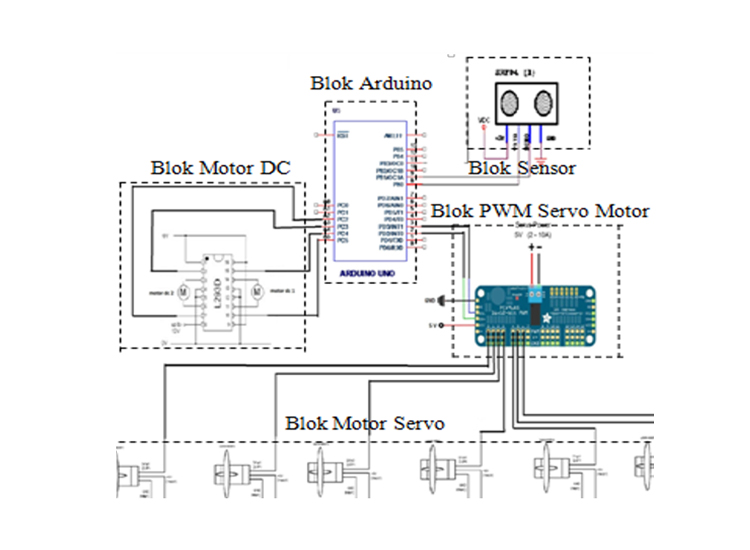// *****************************
// Arm Robot Automatic Conveyor Containet On Tea Factory
// Abraham Patria Yudha Krisnanda
// 2137200777
// Program Studi Sistem Komputer
// STMIK AUB Surakarta
// *****************************
#include <Wire.h>
#include <Adafruit_PWMServoDriver.h>
// called this way, it uses the default address 0x40
Adafruit_PWMServoDriver pwm = Adafruit_PWMServoDriver();
// you can also call it with a different address you want
//Adafruit_PWMServoDriver pwm = Adafruit_PWMServoDriver(0x41);
// Depending on your servo make, the pulse width min and max may vary, you
// want these to be as small/large as possible without hitting the hard stop
// for max range. You'll have to tweak them as necessary to match the servos you
// have!
#define SERVOMIN 125 // this is the 'minimum' pulse length count (out of 4096)
#define SERVOMAX 575 // this is the 'maximum' pulse length count (out of 4096)
// our servo # counter
uint8_t servonum = 1;
#include <AFMotor.h>
#define ECHOPIN A2
#define TRIGPIN A0
int jarak,timer;
char val;
AF_DCMotor motor1(3, MOTOR12_64KHZ); //Jadikan motor 2, 64KHz
AF_DCMotor motor2(2, MOTOR12_64KHZ); //Jadikan motor 2, 64KHz
void setup() {
Serial.begin(9600);
Serial.println("16 channel Servo test!");
pwm.begin();
pwm.setPWMFreq(60); // Analog servos run at ~60 Hz updates
motor1.setSpeed(225); //Set kecepatan motor 240 (Range 0-255)
motor2.setSpeed(225); //Set kecepatan motor 240 (Range 0-255)
Serial.begin(9600); //Kecepatan komunikasi serial
pinMode(ECHOPIN, INPUT);
pinMode(TRIGPIN, OUTPUT);
//yield();
}
void maju()
{
motor1.run(FORWARD); //Motor kiri maju
motor2.run(FORWARD); //Motor kiri maju
}
void mundur()
{
motor1.run(BACKWARD); //Motor kiri maju
motor2.run(BACKWARD); //Motor kiri maju
}
void kiri()
{
motor1.run(FORWARD); //Motor kiri maju
motor2.run(BACKWARD); //Motor kiri maju
}
void kanan()
{
motor1.run(BACKWARD); //Motor kiri maju
motor2.run(FORWARD); //Motor kiri maju
}
void mati()
{
motor1.run(RELEASE); //Motor kiri maju
motor2.run(RELEASE);
}
// the code inside loop() has been updated by Robojax
void loop() {
// tengah -20 tegak
// capit 60-100
// bawah 0 tegak
digitalWrite(TRIGPIN, LOW);
delayMicroseconds(2);
digitalWrite(TRIGPIN, HIGH);
delayMicroseconds(10);
digitalWrite(TRIGPIN, LOW);
timer=0;
while(!ECHOPIN);
timer = pulseIn(ECHOPIN, HIGH);
jarak= timer/58;
Serial.println(jarak);
if ( jarak < 15 )
{
mati();
delay(500);
pwm.setPWM(4, 1, angleToPulse(150) );
delay(2000);
pwm.setPWM(3, 1, angleToPulse(120) );
pwm.setPWM(2, 1, angleToPulse(20) );
delay(12000);
pwm.setPWM(4, 1, angleToPulse(60) );
delay(3000);
//posisi mengambil
pwm.setPWM(3, 1, angleToPulse(80) );
pwm.setPWM(2, 1, angleToPulse(35) );
delay(3000);
pwm.setPWM(1, 1, angleToPulse(100) );
pwm.setPWM(0, 1, angleToPulse(60) );
delay(3000);
pwm.setPWM(0, 1, angleToPulse(100) );
pwm.setPWM(1, 1, angleToPulse(60) );
delay(500);
pwm.setPWM(3, 1, angleToPulse(120) );
pwm.setPWM(2, 1, angleToPulse(20) );
delay(2000);
pwm.setPWM(3, 1, angleToPulse(180) );
delay(1000);
pwm.setPWM(2, 1, angleToPulse(50) );
delay(1000);
pwm.setPWM(1, 1, angleToPulse(100) );
pwm.setPWM(0, 1, angleToPulse(60) );
delay(2000);
pwm.setPWM(4, 1, angleToPulse(150) );
delay(2000);
pwm.setPWM(3, 1, angleToPulse(120) );
pwm.setPWM(2, 1, angleToPulse(20) );
delay(2000);
}
else if ( (digitalRead(2) > 0)&& (digitalRead(0) > 0))
{
maju();
}
else if ( (digitalRead(2) < 1)&& (digitalRead(0) > 0))
{
kanan();
}
else if ( (digitalRead(2) > 0)&& (digitalRead(0) < 1))
{
kiri();
}
}
/*
* angleToPulse(int ang)
* gets angle in degree and returns the pulse width
* also prints the value on seial monitor
* written by Ahmad Nejrabi for Robojax, Robojax.com
*/
int angleToPulse(int ang){
int pulse = map(ang,0, 180, SERVOMIN,SERVOMAX);// map angle of 0 to 180 to Servo min and Servo max
Serial.print("Angle: ");Serial.print(ang);
Serial.print(" pulse: ");Serial.println(pulse);
return pulse;
}




_ztBMuBhMHo.jpg?auto=compress%2Cformat&w=48&h=48&fit=fill&bg=ffffff)







Comments
Please log in or sign up to comment.